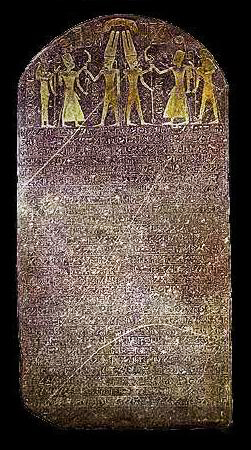
Merenptah (or, in older works, Marniptah), was the pharaoh of the 19th Dynasty of Egypt, reigning from 1224 to 1211 BC. The thirteenth son of Rameses II (nowadays identified as the pharaoh of the Exodus) Merenptah was already well on in years when he succeeded to the throne. Merenptah is not mentioned in the Bible, at least not by name. He, nonetheless, made his mark on biblical history by setting up a stele, a commemorative stone pillar, in his fifth year of reign (1220) celebrating his military accomplishmensts to date. The stele is today referred to generally as the Merentah Stele (or Israel Stele). Abut three-quarters way down the stele he listed these victories in Canaan:
Plundered is the Canaan
with every evil,
Carried off is Ashkelon;
seized upon is Gezer;
. . . Israel is laid waste,
his seed is not;
Hurru is become a widow for Egypt.
This represents the earliest reference to ancient Egypt outside the Bible. The way Israel is referred to suggests that she was not yet a full-grown nation; scholars believe that this best places Israel at this juncture in the time of the settlement, perhaps two or three generations from the conquest under Joshua.

Merenptah represents also the last of the pharaoh's of the great Egyptian empire. His successors were assailed both externally (especially by the so-called Sea People, a fate shared by the Hittites, which vanished from history, and the Assyrians, who were able to recover their power later own) and by interal challenges (the temples grew rich and their priests were sometime able to challenge the pharaoh in power). If Egypt had been able to overcome these assaults to her greatness, the history of ancient Israel would have played out very differently indeed.

©ALBERITH
210313lch